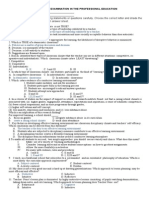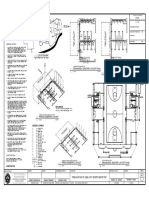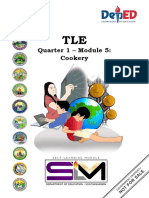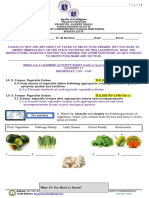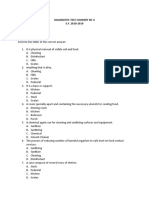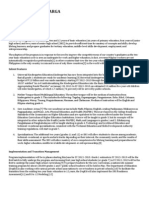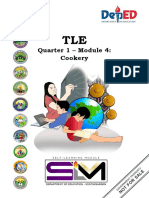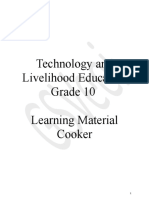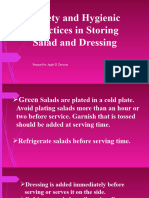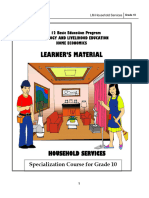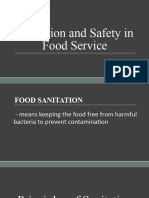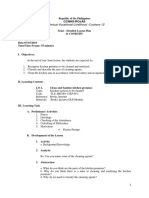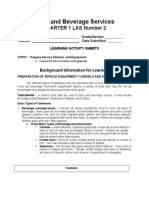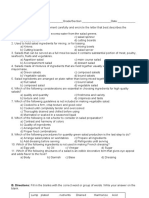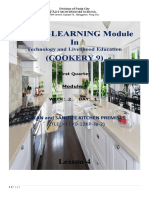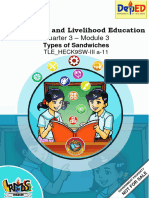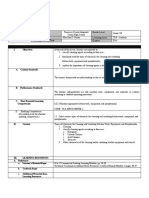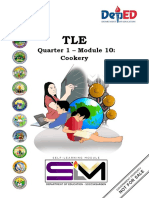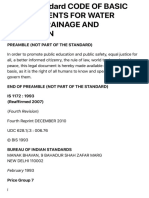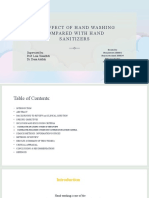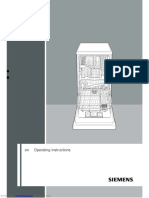Quarter 1 - Module 1: Cookery
Uploaded by
roderic v. perezQuarter 1 - Module 1: Cookery
Uploaded by
roderic v. perez9
TLE
Quarter 1 – Module 1:
Cookery
What I Need to Know
This module was designed and written with you in mind. It is here to help you master
the different chemicals used in cleaning and sanitizing kitchen tools and equipment.
The scope of this module permits it to be used in many different learning situations.
The language used recognizes the diverse vocabulary level of students. The lessons
are arranged to follow the standard sequence of the course. But the order in which
you read them can be changed to correspond with the textbook you are now using.
The module focuses on:
Lesson 1- Clean, Sanitize and Store Kitchen Tools and equipment.
After going through this module, you are expected to:
1. identify the different kinds of chemicals used in cleaning and sanitizing
kitchen tools and equipment.
1
What I Know
Are you ready? Let us do the PRE-TEST.
Test I. Jumbled Letters.Write the correct spelling opposite the scrambled
letters. Write your answer on your test notebook.
1. AINSZTEI - _____________________________
2. PENMEQUTI - ___________________________
3. NGILCAEN - ____________________________
4. CNKTIEH - ______________________________
5. LCEHIMAC - ____________________________
Test II. Multiple Choice:Read the following statements carefully. Choose the
letter that best describes the statement.
1. What cleaning compound is commonly referred to as degreaser and used
on surfaces where grease has burned on?
a. Acid Cleaners
b. b. Abrasives
c. c. Detergents
d. d. Solvent cleaners
2. Which of the following cleaner agent is used generally on removing heavy
accumulations of soil that re difficult to remove?
a. Acid Cleaners
b. Abrasives
c. Detergents
d. Solvent cleaners
3. Which of the following is used in cleaning and sanitizing kitchen tools and
utensils?
a. Ethyl Alcohol
b. b. Chlorine
c. c. Muriatic Acid
d. d. dishwashing liquid
4. Which of the following refers to removing foods and other types of soil from
the surface, such as a dish, glass, or cutting boards?
a. cleaning
b. b. sanitizing
c. c. sweeping
d. d. cooking
2
5. What process refers to removing bacteria through using heat or chemicals?
a. cleaning
b. b. sanitizing
c. c. sweeping
d. d. cooking
Test III.Name 5 cleaning agents commonly used in your household.
1. _________________________ 4.
2. _________________________ 5.
3. _________________________
Lesson Chemicals Used in Cleaning
and Sanitizing Kitchen Tools
1 and Equipment
This lesson introduces the different cleaning compound used in cleaning and
sanitizing tools and equipment. Cleaning and sanitizing procedures must be part of
the standard operating procedures that make up your food safety program.
Improperly cleaned and sanitized surfaces allow harmful microorganisms to be
transferred from one food to another.
What’s In
Notes to the Teacher
Activate the student’s prior knowledge by asking questions about
cleaning and sanitizing.
3
What’s New
Now let us test your ideas about our next lesson. Do the activity “PAIR IT UP”.
ACTIVITY 1: PAIR IT UP.
Try to identify the following pictures. Draw a connecting line to pair the picture
on Colum B to its proper name on Column A.
COLUMN A COLUMN B
a. disinfectant
____ 1.
b. dish soap
c. chlorine
____ 2.
d. sponge
e. detergents
____ 3.
f. soap
____ 4.
____ 5.
4
What is It
Read and study the following topic to answer the next activity.
CHEMICALS USED IN CLEANING and SANITISING KITCHEN TOOLS AND
EQUIPMENT.
Cleaning and sanitizing procedures must be part of the standard operating
procedures that make up your food safety program. Improperly cleaned and sanitized
surfaces allow harmful microorganisms to be transferred from one food to another.
Cleaning is the process of removing food and other types of soil from a surface, such
as a dish, glass, or cutting board. Cleaning is done with a cleaning agent that
removes food, soil, or other substances. The right cleaning agent must be selected
because not all cleaning agents can be used on food-contact surfaces. (A food-contact
surface is the surface of equipment or utensil that food normally comes into contact.)
For example, glass cleaners, some metal cleaners, and most bathroom cleaners
cannot be used because they might leave an unsafe residue on the food contact
surface. The label should indicate if the product can be used on a food-contact
surface. The right cleaning agent must also be selected to make
cleaning easy.
Cleaning Compounds
1. Detergents. These are cleaning agents, solvents or any
substance used to wash tableware, surfaces, and
equipment. Example: soap, soap powders, cleaners, acids,
volatile solvents and abrasives.
2. Solvent Cleaners commonly referred to as degreasers
used on surfaces where grease has burned on. Ovens
and grills are examples of areas that need frequent
degreasing. These products are alkaline based and are
formulated to dissolve grease.
3. Acid Cleaners. Used periodically in removing mineral
deposits and other soils that detergents cannot eliminate
such as scale in washing machines and steam tables, lime
build up on dishwashing machines and rust on shelving.
(Ex.: phosphoric acid, nitric acid, etc.) These products vary
depending on the specific purpose of the product.
4. Abrasives – are generally used to remove heavy
accumulations of soil that are difficult to remove with
detergents, solvents and acids. These products must be
carefully used to avoid damage to the surface being cleaned.
5
Other chemicals used for cleaning and/or sanitizing kitchen equipment and
utensils are the following:
1. ammonia
2. dish washing liquid
3. chlorine
4. carbolic acid
5. timsen
6. disinfectants
7. soap
Answer the following questions based on the topic above.
Question 1: Describe the process of cleaning.
Question 2: Differentiate the four-cleaning compound.
Question 3: Give other chemicals used for cleaning and/ or sanitizing kitchen
equipment and utensils.
6
What’s More
ACTIVITY 2
After studying the topic let us now have our enrichment activity. To do it, read and
follow the instructions below.
Enrichment Activity:
Instruction: At home, observe how your mother or any member of the family of how
they keep your kitchen tools clean. Note the cleaning agents they used and list five
steps on how they clean kitchen tools.
Cleaning Agent 1: ___________________________________
STEPS:
Cleaning Agent 2: ___________________________________
STEPS:
Cleaning Agent 3: ___________________________________
STEPS:
Cleaning Agent 4: ___________________________________
STEPS:
Cleaning Agent 5: ___________________________________
STEPS:
7
What I Have Learned
ACTIVITY 3
Let us now check what you have learned. On your activity sheet, write your
idea about the questions below.
1. How important it is to maintain our kitchen tools and equipment clean?
Give 3 benefits your family can get from it.
_______________________________________________________________________
_______________________________________________________________________
_______________________________________________________________________
______________________________________________________________________ .
2. Name one cleaning compound you commonly used at home. Why do you
used it commonly?
_______________________________________________________________________
_______________________________________________________________________
_______________________________________________________________________
______________________________________________________________________ .
8
What I Can Do
You did Great! Now letus see what you can do on the learnings you gained.
ACTIVITY 4. DO and REFLECT.
Instruction: Remember the enrichment activity you did? Now you will apply what
have you learned. Perform the steps you listed and observed on the previous
activity. After you perform the steps.
On your activity notebook, writes a reflection about your task. Used the following
guide question on creating your Reflection.
Guide Questions:
1. How do you feel doing the task?
2. What were the challenging moments you experience? How did you
overcome those?
3. What are the learnings you discover doing the task?
4. How will you used the learnings you gain in the future.
Assessment
Test I. Multiple Choice: After you answer the Key Stage 1, read the following
statements carefully. Choose the letter that best describes the statement. Write
your answer on your quiz notebook.
1. What cleaning compound is commonly referred to as degreaser and used on
surfaces where grease has burned on?
a. Acid Cleaners
b. Abrasives
c. Detergents
d. Solvent cleaners
2. Which of the following cleaner agent is used generally on removing heavy
accumulations of soil that re difficult to remove?
a. Acid Cleaners
b. Abrasives
c. Detergents
d. Solvent cleaners
9
3. Which of the following is used in cleaning and sanitizing kitchen tools and
utensils?
a. Ethyl Alcohol
b. Chlorine
c. Muriatic Acid
d. dishwashing soap
4. Which of the following refers to removing foods and other types of soil from the
surface, such as a dish, glass, or cutting boards?
a. cleaning
b. sanitizing
c. sweeping
d. cooking
5. What process refers to removing bacteria through using heat or chemicals?
a. cleaning
b. sanitizing
c. sweeping
d. cooking
Test II. Identification: Identify the following statements. Write the correct answer
on your activity sheet.
__________________1. It is used periodically in removing minerals deposits and other
soil that detergents cannot eliminate.
__________________2. It is commonly referred to as degreaser.
__________________3. It is used to remove heavy accumulations of soil.
__________________4. It is the process of killing microorganism.
__________________5. It is routinely used to wash tableware, surfaces and equipment.
Test III.Name 5 cleaning agents commonly used in your household.
1. 4.
2. 5.
3.
Additional Activities
Congratulations! You almost accomplish the module. For your last task, write three
( 3 ) reminders you could share when using cleaning compounds. Note on your
activity notebook.
1.________________________________________________________________________________
2.________________________________________________________________________________
3. _______________________________________________________________________________
10
11
What I Know What's New Assessment
I- 1. Cutting board 1. B
1. SANITIZE 2. D
2. EQUIPMENT
2. Graters
3. A
3. CLEANING 3. Kitchen shears 4. C
4. KITCHEN 4. Colanders 5. E
5. CHEMICAL 5. Funnels II-
II- 1. ACID CLEANER
1.D 2. SOLVENTS
2.B CLEANER
3. D 3. ABRASIVE
4. A CLEANER
5. B 4. SANITIZING
III- 5. DETERGENTS
1. ammonia III-
2. dish washing liquid 1. ammonia
3. chlorine 2. dish washing liquid
4. carbolic acid 3. chlorine
5. timsen 4. carbolic acid
5. timsen
Answer Key
You might also like
- Appetizers /: Wire Whip - Used For Mixing Thinner LiquidsNo ratings yetAppetizers /: Wire Whip - Used For Mixing Thinner Liquids5 pages
- Cooking Utensils List That Every Kitchen NeedsNo ratings yetCooking Utensils List That Every Kitchen Needs50 pages
- K+12, Food Preservation, People Succesful in Food ProcessingNo ratings yetK+12, Food Preservation, People Succesful in Food Processing6 pages
- Safety and Hygienic Practices in Storing Salad andNo ratings yetSafety and Hygienic Practices in Storing Salad and7 pages
- LM Household Services Grade 10 K To 12 BNo ratings yetLM Household Services Grade 10 K To 12 B407 pages
- TLE 9 Sanitation and Safety in Food ServiceNo ratings yetTLE 9 Sanitation and Safety in Food Service25 pages
- Tools and Equipment For Salad Dress Making: Manual Citrus Press Juicer50% (2)Tools and Equipment For Salad Dress Making: Manual Citrus Press Juicer2 pages
- Preparatory Tools and Mixing Tools in CookeryNo ratings yetPreparatory Tools and Mixing Tools in Cookery43 pages
- A.) Directions: Read The Statement Carefully and Encircle The Letter That Best Describes TheNo ratings yetA.) Directions: Read The Statement Carefully and Encircle The Letter That Best Describes The3 pages
- Of Canapés. Write Each Ingredient in The Box Provided For100% (1)Of Canapés. Write Each Ingredient in The Box Provided For7 pages
- Lesson 4 Clean and Sanitize Kitchen PremisesNo ratings yetLesson 4 Clean and Sanitize Kitchen Premises9 pages
- LESSON EXEMPLAR G10 - CookeryTools, Utensils and Equipment Needed in Egg Preparation MAY ANN GUINTO100% (1)LESSON EXEMPLAR G10 - CookeryTools, Utensils and Equipment Needed in Egg Preparation MAY ANN GUINTO5 pages
- Crops Statistics of The Philippines 2016-2020No ratings yetCrops Statistics of The Philippines 2016-2020124 pages
- Hnology and Livelihood Education: Quarter 1 - Module 2: CookeryNo ratings yetHnology and Livelihood Education: Quarter 1 - Module 2: Cookery15 pages
- Hnology and Livelihood Education: Quarter 1 - Module 5: CookeryNo ratings yetHnology and Livelihood Education: Quarter 1 - Module 5: Cookery17 pages
- Hnology and Livelihood Education: Quarter 1 - Module 3: CookeryNo ratings yetHnology and Livelihood Education: Quarter 1 - Module 3: Cookery21 pages
- Indian Standard - Code of Basic Requirements For WaterNo ratings yetIndian Standard - Code of Basic Requirements For Water24 pages
- Page 3 - Big Sister's Wedding - Incest - TabooNo ratings yetPage 3 - Big Sister's Wedding - Incest - Taboo13 pages
- Type of Fixture Maximum Allowable Flow Rate: Toilets 1.6 Gallons Per Flush (GPF)No ratings yetType of Fixture Maximum Allowable Flow Rate: Toilets 1.6 Gallons Per Flush (GPF)3 pages
- Condensed Guidance On Disinfection Solutions (UNHCR 2020) - v1.2No ratings yetCondensed Guidance On Disinfection Solutions (UNHCR 2020) - v1.24 pages
- Caravelle One Piece Round Front Plus - CaromaNo ratings yetCaravelle One Piece Round Front Plus - Caroma2 pages
- Surgical Scrub Drying Hands Closed Gowning and Gloving Gowning and Gloving Another Person and Removing Gown and GlovesNo ratings yetSurgical Scrub Drying Hands Closed Gowning and Gloving Gowning and Gloving Another Person and Removing Gown and Gloves5 pages
- SIEMENS SF24T252GB Operating Instructions ManualNo ratings yetSIEMENS SF24T252GB Operating Instructions Manual28 pages
